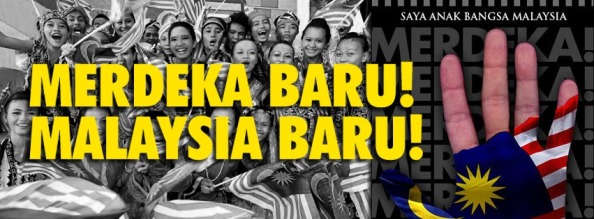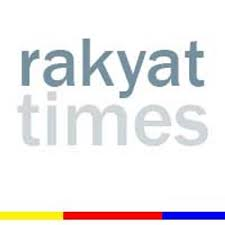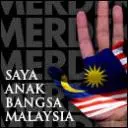
 For a long time, what I knew of 31st, August, 1957, the day Malaya was supposed to have achieved independence from the British, and 16th September, 1963, when Singapore, Sarawak and North Borneo ( now known as Sabah ) confederated with Malaya to form the Federation of Malaysia, was from the history lessons in school.
For a long time, what I knew of 31st, August, 1957, the day Malaya was supposed to have achieved independence from the British, and 16th September, 1963, when Singapore, Sarawak and North Borneo ( now known as Sabah ) confederated with Malaya to form the Federation of Malaysia, was from the history lessons in school.
Which really wasn’t very much.
Certainly, history lessons then did not cater for honest, critical thinking about the efforts to free, first Malaya, and later, Singapore, Sabah and Sarawak from British rule.
We were taught that Singapore left the Federation in 1965.
We were never steered to ask why Singapore left.
In early 2010, in the course of the Saya Anak Bangsa Malaysia road shows in Sabah and Sarawak, I heard, for the first time, and to my utter horror, that Sabah and Sarawak, in joining the Federation, were intended to come in as independent sovereign nations and not the 12th and 13th states.
A fraud on the people of Sabah and Sarawak, I was told, had been perpetrated.
Fahmi Reza’s documentary, “10 tahun sebelum Merdeka”, was an eye-opener for me.
Fahmi documents the events leading up to that famous day on 20th October, 1947, when the people of Malaya, staged a one-day protest, called Hartal, that effectively saw practically all business activity come to a standstill.
It was a demonstration of people power against the British authority.
What prompted this one-day protest?
I urge you to watch this 35-minute documentary to have a fuller understanding of the events leading to this one-day protest of historical proportions.
What is borne out is that in the growing call for independence from British colonial rule, efforts to give shape to that soon-to-be independent nation saw a contestation between two forces.
On the one hand, the British, the Malay rulers, and UMNO.
On the other, the Malay left-wing, the Chinese guilds and the trade unions, under the flag of the PUTERA-AMCJA.
Again, none of this is ever spoken of in history lessons in school.
Fahmi closes his documentary with this very telling information.
The following year, in June, 1948, the British declared a state of emergency.
Political parties were banned or dissolved.
Except UMNO.
Leaders and members of PUTERA-AMCJA were arrested and detained, spending many years in prison or subjected to banishment or restricted residence.
All in, some 30,000 people were detained, supposedly to deal with the communist threat.
Seems almost like we’ve witnessed this in our time, no?
I pause here to make this observation.
Independence, first by Malaya, and subsequently Sabah and Sarawak, is said to have been achieved through protracted negotiations between the British and “leaders”.
A constitution, and later an agreement, drawn up, again, through negotiations between the British and those “leaders”.
I have found little evidence of consultation by those “leaders” with the people of the day.
The people knew only that which those “leaders” would have them know.
Was independence for these three territories real?
If so, that independence was, in my view, lost after 13th May, 1969.
The nation, still under emergency law, watched in silence as Tun Razak dissolved the Alliance comprising UMNO, MCA and MIC and put together the Barisan Nasional with the same UMNO, MCA and MIC, but now bringing on board so many parties from Malaya, Sabah and Sarawak, leaving little semblance of any opposition to serve as a check and balance.
A new colonial master had been born.
The recommendation of the Reid Commission that Article 153 be reviewed in 15 years from 1957 would never happen.
“special position of the Malays” under Article 153(1) would surreptitiously become “special rights of the Malays” and later, “ketuanan Melayu”.
The British divide and rule policy, keeping the three main ethnic groups distrustful of each other, became the mainstay of UMNO, the other parties acquiescing to the same. In time, the other parties, too, would, without reservation, drive this wedge between the various ethnic groups to keep a hold on power.
Whenever the race card proved to not be so efficacious, pitting Islam against anyone or more of the other religions was resorted to.
General Elections were farcical.
In all this, UMNO and BN were aided, at least since the late 80’s, by the mainstream media.
Like the people of the era of 1957 and 1963, the rakyat under the colonial rule of UMNO and BN would only know what the government would have them know.
This changed with the advent of the internet and the ever-increasing access of social media to the rakyat.
In the 12th GE, in 2008, notwithstanding the usual cheating by UMNO and BN, a newly-informed people in Kedah, Penang, Perak and Selangor rose in such numbers that they were able to neutralise the cheating and instal non-UMNO/BN state governments.
For the first time in almost 35 years, UMNO and BN had experienced the potency of a united and arisen people.
Still holding federal power, but now bereft of their 2/3 majority in parliament, UMNO eased Pak Lah out of both the presidency of the party and the PMship of the government and installed Najib.
Would Najib be able to stem the tide of the uprising that was seen in 2008?
In the 13th GE, in 2013, UMNO and BN’s share of the votes dropped to around 47%, yet they took enough seats to still form the government.
Post-election analysis disclosed that UMNO and BN had managed to win 112 seats, the bare minimum to form a simple majority government, by garnering 19.6% of the votes cast.
The Canberra Times reported that “Najib had won the elections on a gerrymander”.
It would not have escaped the attention of Najib, UMNO and BN that the number of voters who had voted for change had grown from 2008.
Last Wednesday, on 9th May, the rakyat went to the polls.
In the months, weeks and days leading up to that fateful day, Najib, UMNO and BN came up with every evil trick they could think up to cheat the rakyat at what had been billed as the “Mother of all elections”.
Their objective : to continue to keep the rakyat subjugated.
A redelineation that disregarded rules laid down in the constitution, bulldozed through parliament.
A anti-fake news law, intended to frighten the rakyat and prevent the viraling of news of corruption scandals, especially into the Malay heartlands.
Fixing polling day on a weekday, in the hope of making it impossible for outstation or overseas voters to travel and vote, thereby reducing the voter turnout.
The list goes on and on.
In my view, Najib, UMNO and BN overlooked one thing.
The most pacifist, peace-loving people, have a breaking point.
Pushed beyond that breaking point, righteous anger wells up, anger turns to courage, whereafter the pacifist looks the bully in the eye and says, “No more”.
Unlike 1957 and 1963, last Wednesday, 9th May, an oppressor was brought to its knees, not by “leaders” negotiating the liberation of a people.
Last Wednesday, 9th May, one people, all united as never before, rose to free this beloved land of ours.
Last Wednesday, 9th May, like our forefathers on 20th October, 1947, the rakyat discovered the power that is in the hands of a united people.
Let our history books now record that on 9th May, 2018, the people of Malaysia were finally free.
Let us now resolve never to be divided again and, as one people, build a nation that is just to all.
Merdeka! Merdeka! Merdeka!
















freeasian
May 14, 2018
Well done, Haris, and a big THANK YOU. All your efforts have paid off. It took a while, but at the end of it, we can say to ourselves that we have fought the good fight, and have won. Time to finally right your upside down SOS distressed flag on your website!
Haris Ibrahim
May 14, 2018
Thanks for the reminder. Will do
Allen Tan
May 14, 2018
God has destined BN to fall. He chose a Wednesday, but it was an date of omen. 509, saw Philippines and South Korea have their presidents changed too.
Paul Warren
May 14, 2018
Excellent summation. Just need to add, the victory UMNO claims for itself for obtaining Merdeka in 1957 was a phyrric one. What kind of Merdeka do you call it when the revenue generating assets of Malaya (plantations and tin mines) continued to be owned by the colonists? Sounds like they were made fools of!